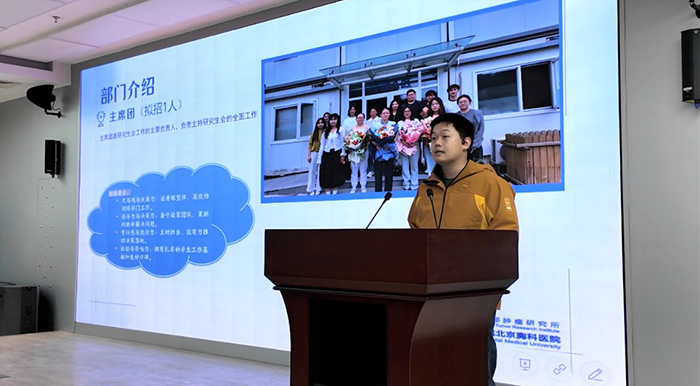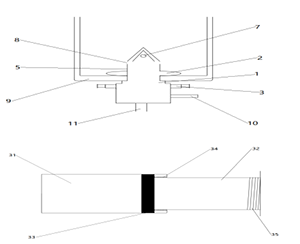2024年
No.5
PubMed
(tuberculosis[Title/Abstract]) OR (lung cancer[Title/Abstract])
Filters applied: from 2024/5/1 - 2024/5/31.
1. J Thorac Oncol. 2024 May;19(5):766-785. doi: 10.1016/j.jtho.2023.10.012. Epub 2023 Oct 20.
The International Association for the Study of Lung Cancer Staging Project for Lung Cancer: Proposals for the Revision of the N Descriptors in the Forthcoming Ninth Edition of the TNM Classification for Lung Cancer.
Huang J(1), Osarogiagbon RU(2), Giroux DJ(3), Nishimura KK(3), Bille A(4), Cardillo G(5), Detterbeck F(6), Kernstine K(7), Kim HK(8), Lievens Y(9), Lim E(10), Marom E(11), Prosch H(12), Putora PM(13), Rami-Porta R(14), Rice D(15), Rocco G(16), Rusch VW(16), Opitz I(17), Vasquez FS(18), Van Schil P(19), Jeffrey Yang CF(20), Asamura H(21); Members of the Staging and Prognostic Factors Committee, Members of the Advisory Boards, and Participating Institutions of the Lung Cancer Domain.
Author information:
(1)Thoracic Service, Memorial Sloan Kettering Cancer Center, New York, New York. Electronic address: huangj@mskcc.org.
(2)Thoracic Oncology Research Group, Multidisciplinary Thoracic Oncology Program, Baptist Cancer Center, Memphis, Tennessee.
(3)Cancer Research and Biostatistics, Seattle, Washington.
(4)Department of Thoracic Surgery, Guys Hospital, London, United Kingdom; School
of Cancer and Pharmaceutical Sciences, Kings College University, London, United Kingdom.
(5)Unit of Thoracic Surgery, Azienda Ospedaliera San Camillo-Forlanini, Rome, Italy; UniCamillus-Saint Camillus International University of Health Sciences, Rome, Italy.
INTRODUCTION: The accurate assessment of nodal (N) status is crucial to the management and prognostication of nonmetastatic NSCLC. We sought to determine whether the current N descriptors should be maintained or revised for the upcoming ninth edition of the international TNM lung cancer staging system.
METHODS: Data were assembled by the International Association for the Study of Lung Cancer on patients with NSCLC, detailing both clinical and pathologic N status, with information about anatomical location and individual station-level identification. Survival was calculated by the Kaplan-Meier method and prognostic groups were assessed by a Cox regression analysis.
RESULTS: Data for clinical N and pathologic N status were available in 45,032 and 35,009 patients, respectively. The current N0 to N3 descriptors for both clinical N and pathologic N categories reflect prognostically distinct groups. Furthermore, single-station N2 involvement (N2a) exhibited a better prognosis than multistation N2 involvement (N2b) in both clinical and pathologic classifications, and the differences between all neighboring nodal subcategories were highly significant. The prognostic differences between N2a and N2b were robust and consistent across resection status, histologic type, T category, and geographic region.
CONCLUSIONS: The current N descriptors should be maintained, with the addition of new subdescriptors to N2 for single-station involvement (N2a) and multiple-station involvement (N2b).
Copyright © 2023 International Association for the Study of Lung Cancer. All rights reserved.
DOI: 10.1016/j.jtho.2023.10.012
PMID: 37866624 [Indexed for MEDLINE]
2. J Thorac Oncol. 2024 May;19(5):749-765. doi: 10.1016/j.jtho.2023.12.006. Epub 2023 Dec 7.
The International Association for the Study of Lung Cancer Lung Cancer Staging Project: Proposals for the Revisions of the T-Descriptors in the Forthcoming Ninth Edition of the TNM Classification for Lung Cancer.
Van Schil PE(1), Asamura H(2), Nishimura KK(3), Rami-Porta R(4), Kim YT(5), Bertoglio P(6), Cangir AK(7), Donington J(8), Fang W(9), Giroux DJ(3), Lievens Y(10), Liu H(11), Lyons G(12), Sakai S(13), Travis WD(14), Ugalde P(15), Jeffrey Yang CF(16), Yotsukura M(17), Detterbeck F(18); Members of the International Association for the Study of Lung Cancer Staging and Prognostic Factors Committee, Advisory Boards and Participating Institutions.
Author information:
(1)Department of Thoracic and Vascular Surgery, Antwerp University Hospital and Antwerp University, Antwerp, Belgium. Electronic address: paul.van.schil@uza.be.
(2)Division of Thoracic Surgery, Keio University School of Medicine, Tokyo, Japan.
(3)Cancer Research And Biostatistics, Seattle, Washington.
(4)Department of Thoracic Surgery, Hospital Universitari Mútua Terrassa, University of Barcelona; CIBERES Lung Cancer Group, Terrassa, Barcelona, Spain.
(5)Department of Thoracic and Cardiovascular Surgery, Seoul National University Hospital, Seoul National University College of Medicine, Seoul, Republic of Korea.
INTRODUCTION: An international database was created by the International Association for the Study of Lung Cancer to inform on the ninth edition of the TNM classification of lung cancer. The present analyses concern its T component.
METHODS: Data on 124,581 patients diagnosed with lung cancer from January 1, 2011 to December 31, 2019 were submitted to the International Association for the Study of Lung Cancer database. Of these, 33,982 met the inclusion criteria for the clinical T analysis, and 30,715 met the inclusion criteria for the pathologic postsurgical analysis. Survival was measured from the date of diagnosis or operation for clinically and pathologically staged tumors, respectively. T descriptors were evaluated in univariate analysis and multivariable Cox regression analysis adjusted for age, sex, pathologic type,and geographic region.
RESULTS: Comprehensive survival analysis revealed that the existing eighth edition T component criteria performed adequately in the ninth edition data set. Although pathologic chest wall or parietal pleura involvement (PL 3) yielded a worse survival compared with the other T3 descriptors, with a similar survival as T4 tumors, this difference was not observed for clinical chest wall or PL 3 tumors. Because of these inconsistent findings, no reallocation of chest wall or PL 3 tumors is advised.
CONCLUSIONS: The T subcommittee members proposed not to implement any changes and keep the current eighth-edition T descriptors for the ninth edition.
Copyright © 2023 International Association for the Study of Lung Cancer. Published by Elsevier Inc. All rights reserved.
DOI: 10.1016/j.jtho.2023.12.006
PMCID: PMC11081813
PMID: 38070600 [Indexed for MEDLINE]
3. J Thorac Oncol. 2024 May;19(5):786-802. doi: 10.1016/j.jtho.2024.01.019. Epub 2024 Feb 4.
The International Association for the Study of Lung Cancer Staging Project for Lung Cancer: Proposals for the Revision of the M Descriptors in the Forthcoming Ninth Edition of the TNM Classification for Lung Cancer.
Fong KM(1), Rosenthal A(2), Giroux DJ(2), Nishimura KK(2), Erasmus J(3), Lievens Y(4), Marino M(5), Marom EM(6), Putora PM(7), Singh N(8), Suárez F(9), Rami-Porta R(10), Detterbeck F(11), Eberhardt WEE(12), Asamura H(13); Members of the International Association for the Study of Lung Cancer Staging and Prognostic Factors Committee, Members of the Advisory Boards, and Participating Institutions of the Lung Cancer Domain.
Author information:
(1)Department of Thoracic Medicine, The Prince Charles Hospital, University of Queensland Thoracic Research Centre, Brisbane, Australia. Electronic address: kwun.fong@health.qld.gov.au.
(2)Cancer Research And Biostatistics (CRAB), Seattle, Washington.
(3)Department of Thoracic Imaging, The University of Texas MD Anderson Cancer Center, Houston, Texas.
(4)Department of Radiation Oncology, Ghent University Hospital and Ghent University, Gent, Belgium.
(5)Department of Pathology, IRCCS Regina Elena National Cancer Institute, Rome, Italy.
INTRODUCTION: This study analyzed all metastatic categories of the current TNM classification of NSCLC to propose modifications of the M component in the next edition (ninth) of the classification.
METHODS: A database of 124,581 patients diagnosed between 2011 and 2019 was established; of these, 14,937 with NSCLC in stages IVA to IVB were available for this analysis. Overall survival was calculated using the Kaplan-Meier method, and prognosis was assessed using multivariable-adjusted Cox proportional hazards regression.
RESULTS: The eighth edition M categories revealed good discrimination in the ninth edition data set. Assessments revealed that an increasing number of metastatic lesions were associated with decreasing prognosis; because this seems to be a continuum and adjustment for confounders was not possible, no specific lesion number was deemed appropriate for stage classification. Among tumors involving multiple metastases, decreasing prognosis was found with an increasing number of organ systems involved. Multiple assessments, including after adjustment for potential confounders, revealed that M1c patients who had metastases to a single extrathoracic organ system were prognostically distinct from M1c patients who had involvement of multiple extrathoracic organ systems.
CONCLUSIONS: These data validate the eighth edition M1a and M1b categories, which are recommended to be maintained. We propose the M1c category be divided into M1c1 (involvement of a single extrathoracic organ system) and M1c2 (involvement of multiple extrathoracic organ systems).
Copyright © 2024 International Association for the Study of Lung Cancer. Published by Elsevier Inc. All rights reserved.
DOI: 10.1016/j.jtho.2024.01.019
PMID: 38320664 [Indexed for MEDLINE]
4. Eur Respir J. 2024 May 2;63(5):2301809. doi: 10.1183/13993003.01809-2023. Print 2024 May.
High risk of lung cancer in surfactant-related gene variant carriers.
Brudon A(1)(2)(3), Legendre M(4)(5)(3), Mageau A(6)(7), Bermudez J(8)(9), Bonniaud P(10), Bouvry D(11)(12), Cadranel J(13)(14), Cazes A(15)(16), Crestani B(16)(17), Dégot T(18), Delestrain C(19)(20), Diesler R(21)(22), Epaud R(18)(19), Philippot Q(16)(17), Théou-Anton N(23)(24), Kannengiesser C(22)(23), Ba I(22)(23), Debray MP(23)(24), Fanen P(19)(24), Manali E(25), Papiris S(26), Nathan N(5)(27), Amselem S(4)(5), Gondouin A(28), Guillaumot A(29), Andréjak C(30)(31), Jouneau S(32), Beltramo G(10), Uzunhan Y(11), Galodé F(33), Westeel V(27), Mehdaoui A(34), Hirschi S(35), Leroy S(36)(37), Marchand-Adam S(38)(39), Nunes H(11)(12), Picard C(40), Prévot G(41), Reynaud-Gaubert M(8)(9), De Vuyst P(42), Wemeau L(43), Defossez G(3), Zalcman G(1)(2), Cottin V(20)(21), Borie R(44)(17); OrphaLung network.
Author information:
(1)Service d'Oncologie Thoracique, Hôpital Bichat, AP-HP, Institut du Cancer AP-HP Nord, Paris, France.
(2)Université Paris Cité, Inserm CIC-EC 1425, Paris, France.
(3)A. Brudon and M. Legendre contributed equally to this work.
(4)UF de Génétique Moléculaire, Hôpital Armand Trousseau, AP-HP, Paris, France.
(5)Sorbonne Université, Inserm UMR-S 933, Maladies Génétiques d'Expression Pédiatrique, Paris, France.
BACKGROUND: Several rare surfactant-related gene (SRG) variants associated with interstitial lung disease are suspected to be associated with lung cancer, but data are missing. We aimed to study the epidemiology and phenotype of lung cancer in an international cohort of SRG variant carriers.
METHODS: We conducted a cross-sectional study of all adults with SRG variants in the OrphaLung network and compared lung cancer risk with telomere-related gene (TRG) variant carriers.
RESULTS: We identified 99 SRG adult variant carriers (SFTPA1 (n=18), SFTPA2 (n=31), SFTPC (n=24), ABCA3 (n=14) and NKX2-1 (n=12)), including 20 (20.2%) with lung cancer (SFTPA1 (n=7), SFTPA2 (n=8), SFTPC (n=3), NKX2-1 (n=2) and ABCA3 (n=0)). Among SRG variant carriers, the odds of lung cancer was associated with age (OR 1.04, 95% CI 1.01-1.08), smoking (OR 20.7, 95% CI 6.60-76.2) and SFTPA1/SFTPA2 variants (OR 3.97, 95% CI 1.39-13.2). Adenocarcinoma was the only histological type reported, with programmed death ligand-1 expression ≥1% in tumour cells in three samples. Cancer staging was localised (I/II) in eight (40%) individuals, locally advanced (III) in two (10%) and metastatic (IV) in 10 (50%). We found no somatic variant eligible for targeted therapy. Seven cancers were surgically removed, 10 received systemic therapy, and three received the best supportive care according to their stage and performance status. The median overall survival was 24 months, with stage I/II cancers showing better survival. We identified 233 TRG variant carriers. The comparative risk (subdistribution hazard ratio) for lung cancer in SRG patients versus TRG patients was 18.1 (95% CI 7.1-44.7).
CONCLUSIONS: The high risk of lung cancer among SRG variant carriers suggests specific screening and diagnostic and therapeutic challenges. The benefit of regular computed tomography scan follow-up should be evaluated.
Copyright ©The authors 2024.
DOI: 10.1183/13993003.01809-2023
PMCID: PMC11063619
PMID: 38575158 [Indexed for MEDLINE]
5. Eur Respir J. 2024 May 30;63(5):2301181. doi: 10.1183/13993003.01181-2023. Print 2024 May.
Association between high levels of nitrogen dioxide and increased cumulative incidence of lung cancer in patients with idiopathic pulmonary fibrosis.
Yoon HY(1), Kim SY(2), Song JW(3).
Author information:
(1)Division of Allergy and Respiratory Diseases, Department of Internal Medicine, Soonchunhyang University Seoul Hospital, Seoul, Republic of Korea.
(2)Department of Cancer AI and Digital Health, Graduate School of Cancer Science and Policy, National Cancer Center, Gyeonggi, Republic of Korea.
(3)Department of Pulmonary and Critical Care Medicine, Asan Medical Center, University of Ulsan College of Medicine, Seoul, Republic of Korea
jwsongasan@gmail.com.
Comment in
Eur Respir J. 2024 May 30;63(5):2400760. doi: 10.1183/13993003.00760-2024.
BACKGROUND: Lung cancer is a fatal complication of idiopathic pulmonary fibrosis (IPF) with a poor prognosis. However, the association between individual exposure to air pollutants and lung cancer development in patients with IPF is unknown. This study aimed to assess the effect of individual exposure to nitrogen dioxide (NO2) on lung cancer development in patients with IPF.
METHODS: We enrolled 1085 patients from an IPF cohort in the Republic of Korea (mean age 65.6 years, males 80.6%). We estimated individual-level long-term exposures to NO2 at the patients' residential addresses using a national-scale exposure prediction model based on data from air quality regulatory monitoring stations. To evaluate the association between NO2 levels and lung cancer development in IPF, we used an individual- and area-level covariates adjusted model as our primary model.
RESULTS: The estimated average annual NO2 concentration was 23.1 ppb. During a median follow-up of 4.3 years, 86 patients (7.9%) developed lung cancer. NO2 concentration was associated with lung cancer development in an unadjusted model (HR 1.219; p=0.042), while a marginal association was found in the primary model (HR 1.280; p=0.084). When NO2 concentration was stratified by the median value (21.0 ppb), exposure to high NO2 levels (≥21.0 ppb) was associated with a 2.0-fold increase in the risk of lung cancer development (HR 2.023; p=0.047) in the primary model.
CONCLUSION: Individual exposure to high NO2 levels may increase the risk of lung cancer development in patients with IPF.
Copyright ©The authors 2024. For reproduction rights and permissions contact
permissions@ersnet.org.
DOI: 10.1183/13993003.01181-2023
PMID: 38453259 [Indexed for MEDLINE]
6. Lancet Respir Med. 2024 May 8:S2213-2600(24)00083-3. doi: 10.1016/S2213-2600(24)00083-3. Online ahead of print.
Effectiveness of preventive treatment among different age groups and Mycobacterium tuberculosis infection status: a systematic review and individual-participant data meta-analysis of contact tracing studies.
Martinez L(1), Seddon JA(2), Horsburgh CR(3), Lange C(4), Mandalakas AM(5); TB Contact Studies Consortium.
Author information:
(1)Boston University School of Public Health, Department of Epidemiology, Boston, MA, USA. Electronic address: leomarti@bu.edu.
(2)Desmond Tutu TB Centre, Department of Paediatrics and Child Health, Stellenbosch University, Stellenbosch, South Africa; Department of Infectious Disease, Imperial College London, London, UK.
(3)Boston University School of Public Health, Department of Epidemiology, Boston, MA, USA.
(4)German Center for Infection Research, Partner Site Hamburg-Lübeck-Borstel-Riems, Borstel, Germany; Global TB and Immigrant Health Program, Baylor College of Medicine and Texas Children's Hospital, Houston, TX, USA; Division of Clinical Infectious Diseases, Research Center Borstel, Borstel, Germany; Respiratory Medicine & International Health, University of Lübeck, Lübeck, Germany.
(5)German Center for Infection Research, Partner Site Hamburg-Lübeck-Borstel-Riems, Borstel, Germany; Global TB and Immigrant Health Program, Baylor College of Medicine and Texas Children's Hospital, Houston, TX, USA; Division of Clinical Infectious Diseases, Research Center Borstel, Borstel, Germany.
BACKGROUND: Tuberculosis is a preventable disease. However, there is debateregarding which individuals would benefit most from tuberculosis preventive treatment and whether these benefits vary in settings with a high burden and low burden of tuberculosis. We aimed to compare the effectiveness of tuberculosis preventive treatment in exposed individuals of differing ages and Mycobacterium tuberculosis infection status while considering tuberculosis burden of the settings.
METHODS: In this systematic review and individual-participant meta-analysis, we investigated the development of incident tuberculosis in people closely exposed to individuals with tuberculosis. We searched for studies published between Jan 1, 1998, and April 6, 2018, in MEDLINE, Web of Science, BIOSIS, and Embase. We restricted our search to cohort studies; case-control studies and outbreak reports were excluded. Two reviewers evaluated titles, abstracts, and full text articles for eligibility. At each stage, two reviewers discussed discrepancies and re-evaluated articles until a consensus was reached. Individual-participant data and a pre-specified list of variables, including characteristics of the exposed contact, the index patient, and environmental characteristics, were requested from authors of all eligible studies; contacts exposed to a drug-resistant tuberculosis index patient were excluded. The primary study outcome was incident tuberculosis. We estimated adjusted hazard ratios (aHRs) for incident tuberculosis with mixed-effects Cox regression models with a study-level random effect. We estimated the number-needed-to-treat (NNT) to prevent one person developing tuberculosis. Propensity score matching procedures were used in all analyses. This study is registered with PROSPERO (CRD42018087022).
FINDINGS: After screening 25 358 records for eligibility, 439 644 participants from 32 cohort studies were included in the individual-participant data meta-analysis. Participants were followed for 1 396 413 person-years (median of 2·7 years [IQR 1·3-4.4]), during which 2496 people were diagnosed with incident tuberculosis. Overall, effectiveness of preventive treatment was 49% (aHR 0·51 [95% CI 0·44-0·60]). Participants with a positive tuberculin-skin-test (TST) or IFNγ release assay (IGRA) result at baseline benefitted from greater protection, regardless of age (0·09 [0·05-0·17] in children younger than 5 years, 0·20 [0·15-0·28] in individuals aged 5-17 years, and 0·17 [0·13-0·22] in adults aged 18 years and older). The effectiveness of preventive treatment was greater in high-burden (0·31 [0·23-0·40]) versus low-burden (0·58 [0·47-0·72]) settings. The NNT ranged from 9 to 34 depending on age among participants with a positive TST or IGRA in both high-burden and low-burden settings; among all contacts (regardless of TST or IGRA test result), the NNT ranged from 29 to 43 in high-burden settings and 213 to 455 in low-burden settings.
INTERPRETATION: Our findings suggest that a risk-targeted strategy prioritising contacts with evidence of M tuberculosis infection might be indicated in low-burden settings, and a broad approach including all contacts should be considered in high-burden settings. Preventive treatment was similarly effective among contacts of all ages.
FUNDING: None.
2024 Elsevier Ltd. All rights reserved, including those for text and data mining, AI training, and similar technologies.
DOI: 10.1016/S2213-2600(24)00083-3
PMID: 38734022
7. Lancet Public Health. 2024 May;9(5): e339-e344. doi: 10.1016/S2468-2667(24)00046-X. Epub 2024 Mar 23.
Achieving universal social protection for people with tuberculosis.
Fuady A(1), Hutanamon T(2), Herlinda O(3), Luntungan N(2), Wingfield T(4).
Author information:
(1)Department of Community Medicine, Faculty of Medicine, Universitas Indonesia, Jakarta, Indonesia; Evidence-based Health Policy Centre, Indonesian Medical Education and Research Institute, Faculty of Medicine, Universitas Indonesia, Jakarta, Indonesia. Electronic address: ahmad.fuady01@ui.ac.id.
(2)Stop TB Partnership Indonesia, Jakarta, Indonesia.
(3)Stop TB Partnership Indonesia, Jakarta, Indonesia; Research and Policy Division, Center for Indonesia's Strategic Development Initiatives, Jakarta, Indonesia.
(4)Centre for Tuberculosis Research, Department of Clinical Sciences and International Public Health, Liverpool School of Tropical Medicine, Liverpool, UK; Department of Global Public Health, WHO Collaborating Centre on Tuberculosis and Social Medicine, Karolinska Institute, Stockholm, Sweden; Tropical and Infectious Disease Unit, Royal Liverpool and Broadgreen University Hospitals NHS Trust, Liverpool, UK.
As we mark World TB Day 2024, we take this opportunity to reflect on the 2023 UN General Assembly High-Level Meeting (HLM) on the fight against tuberculosis-a milestone in the commitment towards a more coordinated, comprehensive approach to end tuberculosis globally. The UN HLM declaration on the fight against tuberculosis includes a specific pledge that all people with tuberculosis should receive a social benefits package to mitigate financial hardship. However, it is not known how this specific pledge will be realised and through which concrete actions. The use of the term financial hardship instead of WHO's key End TB Strategy indicator of catastrophic costs might prove challenging for robust evaluation of both the socioeconomic impact of tuberculosis and the effectiveness of socioeconomic support strategies to mitigate this impact. Moreover, in contrast to the financial pledges made for biomedical interventions, there was an absence of explicit investment in social protection. Such investments are imperative to facilitate successful expansion of social protection to meet the needs of people with tuberculosis and their households. Successful expansion of social protection is also dependent on political commitment and protected budgets from relevant stakeholders, including across government ministries. These strategies will help to ensure that the commitments on social protection made in the UN HLM declaration are turned into tangible actions with measurable effects.
Copyright © 2024 The Author(s). Published by Elsevier Ltd. This is an Open Access article under the CC BY 4.0 license. Published by Elsevier Ltd.. All rights reserved.
DOI: 10.1016/S2468-2667(24)00046-X
PMID: 38531368 [Indexed for MEDLINE]
8. J Clin Oncol. 2024 May 10;42(14):1646-1654. doi: 10.1200/JCO.23.01045. Epub 2024 Mar 13.
Racial and Ethnic Disparities in Intensity of Care at the End of Life for Patients With Lung Cancer: A 13-Year Population-Based Study.
Rodriguez GM(1), Popat R(2)(3), Rosas LG(2)(3), Patel MI(2)(4).
Author information:
(1)Department of Medicine, Northwestern University Feinberg School of Medicine and the Comprehensive Cancer Center, Chicago, IL.
(2)Stanford University School of Medicine, Stanford, CA.
(3)Department of Epidemiology and Population Health, Stanford, CA.
(4)Veterans Affairs Palo Alto Health Care System, Palo Alto, CA.
PURPOSE: Lung cancer is the leading cause of cancer death in the United States. Disparities in lung cancer mortality among racial and ethnic minorities are well documented. Less is known as to whether racial and ethnic minority patients with lung cancer experience higher rates of intensity of care at the end of life (EOL) compared with non-Hispanic White (NHW) patients.
METHODS: We conducted a population-based analysis of patients 18 years and older with a lung cancer diagnosis who died between 2005 and 2018 using the California Cancer Registry linked to patient discharge data abstracts. Our primary outcome was intensity of care in the last 14 days before death (defined as any hospital admission or emergency department [ED] visit, intensive care unit [ICU] admission, intubation, cardiopulmonary resuscitation [CPR], hemodialysis, and death in an acute care setting). We used multivariable logistic regression models to evaluate associations between race and ethnicity and intensity of EOL care.
RESULTS: Among 207,429 patients with lung cancer who died from 2005 to 2018, the median age was 74 years (range, 18-107) and 106,821 (51%) were male, 146,872 (70.8%) were NHW, 1,045 (0.5%) were American Indian, 21,697 (10.5%) were Asian Pacific Islander (API), 15,490 (7.5%) were Black, and 22,325 (10.8%) were Hispanic. Compared with NHW patients, in the last 14 days before death, API, Black, and Hispanic patients had greater odds of a hospital admission, an ICU admission, intubation, CPR, and hemodialysis and greater odds of a hospital or ED death.
CONCLUSION: Compared with NHW patients, API, Black, and Hispanic patients who died with lung cancer experienced higher intensity of EOL care. Future studies should develop approaches to eliminate such racial and ethnic disparities in care delivery at the EOL.
DOI: 10.1200/JCO.23.01045
PMCID: PMC11095875
PMID: 38478794 [Indexed for MEDLINE]
9. Lancet Glob Health. 2024 May;12(5):e783-e792. doi: 10.1016/S2214-109X(24)00029-9. Epub 2024 Apr 4.
Blood RNA biomarkers for tuberculosis screening in people living with HIV before antiretroviral therapy initiation: a diagnostic accuracy study.
Mann T(1), Gupta RK(2), Reeve BWP(3), Ndlangalavu G(3), Chandran A(1), Krishna AP(1), Calderwood CJ(4), Tshivhula H(3), Palmer Z(3), Naidoo S(3), Mbu DL(3), Theron G(3), Noursadeghi M(5).
Author information:
(1)Division of Infection and Immunity, University College London, London, UK.
(2)Institute of Health Informatics, University College London, London, UK.
(3)DSI-NRF Centre of Excellence for Biomedical Tuberculosis Research, South African Medical Research Council Centre for Tuberculosis Research, Division of Molecular Biology and Human Genetics, Faculty of Medicine and Health Sciences,
Stellenbosch University, Cape Town, South Africa.
(4)Department of Clinical Research, Faculty of Infectious and Tropical Diseases, London School of Hygiene & Tropical Medicine, London, UK.
(5)Division of Infection and Immunity, University College London, London, UK. Electronic address: m.noursadeghi@ucl.ac.uk.
Update of
medRxiv. 2023 Jun 04:2023.06.01.23290783. doi: 10.1101/2023.06.01.23290783.
BACKGROUND: Undiagnosed tuberculosis remains a major threat for people living with HIV. Multiple blood transcriptomic biomarkers have shown promise for tuberculosis diagnosis. We sought to evaluate their diagnostic accuracy and clinical utility for systematic pre-antiretroviral therapy (ART) tuberculosis screening.
METHODS: We enrolled consecutive adults (age ≥18 years) referred to start ART at a community health centre in Cape Town, South Africa, irrespective of symptoms. Sputa were obtained (using induction if required) for two liquid cultures. Whole-blood RNA samples underwent transcriptional profiling using a custom Nanostring gene panel. We measured the diagnostic accuracy of seven candidate RNA signatures (one single gene biomarker [BATF2] and six multigene biomarkers) for the reference standard of Mycobacterium tuberculosis culture status, using area under the receiver-operating characteristic curve (AUROC) analysis, and sensitivity and specificity at prespecified thresholds (two standard scores above the mean of healthy controls; Z2). Clinical utility was assessed by calculating net benefit in decision curve analysis. We compared performance with C-reactive protein (CRP; threshold ≥5 mg/L), WHO four-symptom screen (W4SS), and the WHO target product profile for tuberculosis triage tests.
FINDINGS: A total of 707 people living with HIV (407 [58%] female and 300 [42%] male) were included, with median CD4 count 306 cells per mm3 (IQR 184-486). Of 676 participants with available sputum culture results, 89 (13%) had culture-confirmed tuberculosis. The seven RNA signatures were moderately to highly correlated (Spearman rank coefficients 0·42-0·93) and discriminated tuberculosis culture positivity with similar AUROCs (0·73-0·80), but none statistically better than CRP (AUROC 0·78, 95% CI 0·72-0·83). Diagnostic accuracy was similar across CD4 count strata, but lower among participants with negative W4SS (AUROCs 0·56-0·65) compared with positive (AUROCs 0·75-0·84). The RNA biomarker with the highest AUROC point estimate was a four-gene signature (Suliman4; AUROC 0·80, 95% CI 0·75-0·86), with sensitivity 83% (95% CI 74-90) and specificity 59% (55-63) at the Z2 threshold. In decision curve analysis, Suliman4 and CRP had similar clinical utility to guide confirmatory tuberculosis testing, but both had higher net benefit than W4SS. In exploratory analyses, an approach combining CRP (≥5 mg/L) and Suliman4 (≥Z2) had sensitivity of 80% (70-87), specificity of 70% (66-74), and higher net benefit than either biomarker alone.
INTERPRETATION: RNA biomarkers showed better clinical utility to guide confirmatory tuberculosis testing for people living with HIV before ART initiation than symptom-based screening, but their performance did not exceed that of CRP and fell short of WHO recommended targets. Interferon-independent approaches might be required to improve accuracy of host-response biomarkers to support tuberculosis screening before ART initiation.
FUNDING: South African Medical Research Council, European and Developing Countries Clinical Trials Partnership 2, National Institutes of Health National Institute of Allergy and Infectious Diseases, The Wellcome Trust, National Institute for Health and Care Research, Royal College of Physicians London.
Copyright © 2024 The Author(s). Published by Elsevier Ltd. This is an Open Access article under the CC BY 4.0 license. Published by Elsevier Ltd.. All rights reserved.
DOI: 10.1016/S2214-109X(24)00029-9
PMID: 38583459 [Indexed for MEDLINE]
10. J Thorac Oncol. 2024 May 16:S1556-0864(24)00211-9. doi: 10.1016/ j.jtho.2024. 05.006. Online ahead of print.
A Real-World Assessment of Stage I Lung Cancer Through Electronic Nose Technology.
Rocco G(1), Pennazza G(2), Tan KS(3), Vanstraelen S(4), Santonico M(5), Corba RJ(4), Park BJ(4), Sihag S(4), Bott MJ(4), Crucitti P(6), Isbell JM(4), Ginsberg MS(7), Weiss H(8), Incalzi RA(9), Finamore P(6), Longo F(6), Zompanti A(2), Grasso S(5), Solomon SB(7), Vincent A(4), McKnight A(4), Cirelli M(4), Voli C(4), Kelly S(4), Merone M(10), Molena D(4), Gray K(4), Huang J(4), Rusch VW(4), Bains MS(4), Downey RJ(4), Adusumilli PS(4), Jones DR(11).
Author information:
(1)Thoracic Service, Department of Surgery, Memorial Sloan Kettering Cancer Center, New York, New York; Druckenmiller Center for Lung Cancer Research, Memorial Sloan Kettering Cancer Center, New York, New York. Electronic address: roccog@mskcc.org.
(2)Department of Engineering, Unit of Electronics for Sensor Systems, Università Campus Bio-Medico di Roma, Rome, Italy.
(3)Department of Epidemiology and Biostatistics, Memorial Sloan Kettering Cancer Center, New York, New York.
(4)Thoracic Service, Department of Surgery, Memorial Sloan Kettering Cancer Center, New York, New York.
(5)Department of Science and Technology for Sustainable Development and One Health, Unit of Electronics for Sensor Systems, Università Campus Bio-Medico di Roma, Rome, Italy.
INTRODUCTION: Electronic nose (E-nose) technology has reported excellent sensitivity and specificity in the setting of lung cancer screening. However, the performance of E-nose specifically for early-stage tumors remains unclear. Therefore, the aim of our study was to assess the diagnostic performance of E-nose technology in clinical stage I lung cancer.
METHODS: This phase IIc trial (NCT04734145) included patients diagnosed with a single greater than or equal to 50% solid stage I nodule. Exhalates were prospectively collected from January 2020 to August 2023. Blinded bioengineers analyzed the exhalates, using E-nose technology to determine the probability of malignancy. Patients were stratified into three risk groups (low-risk, [<0.2]; moderate-risk, [≥0.2-0.7]; high-risk, [≥0.7]). The primary outcome was the diagnostic performance of E-nose versus histopathology (accuracy and F1 score). The secondary outcome was the clinical performance of the E-nose versus clinicoradiological prediction models.
RESULTS: Based on the predefined cutoff (<0.20), E-nose agreed with histopathologic results in 86% of cases, achieving an F1 score of 92.5%, based on 86 true positives, two false negatives, and 12 false positives (n = 100). E-nose would refer fewer patients with malignant nodules to observation (low-risk: 2 versus 9 and 11, respectively; p = 0.028 and p = 0.011) than would the Swensen and Brock models and more patients with malignant nodules to treatment without biopsy (high-risk: 27 versus 19 and 6, respectively; p = 0.057 and p < 0.001).
CONCLUSIONS: In the setting of clinical stage I lung cancer, E-nose agrees well with histopathology. Accordingly, E-nose technology can be used in addition to imaging or as part of a "multiomics" platform.
Copyright © 2024 International Association for the Study of Lung Cancer. Published by Elsevier Inc. All rights reserved.
DOI: 10.1016/j.jtho.2024.05.006
PMID: 38762120
11. Lancet Child Adolesc Health. 2024 May;8(5):369-378. doi: 10.1016/S2352-4642(23)00345-0. Epub 2024 Mar 21.
Management of the infant born to a mother with tuberculosis: a systematic review and consensus practice guideline.
Hasan N(1), Nourse C(2), Schaaf HS(3), Bekker A(3), Loveday M(4), Alcântara Gabardo BM(5), Coulter C(6), Chabala C(7), Kabra S(8), Moore E(9), Maleche-Obimbo E(10), Salazar-Austin N(11), Ritz N(12), Starke JR(13), Steenhoff AP(14), Triasih R(15), Welch SB(16), Marais BJ(17).
Author information:
(1)Faculty of Medicine, University of Queensland, Brisbane, QLD, Australia; General Paediatrics, The Queensland Children's Hospital, Brisbane, QLD, Australia.
(2)Faculty of Medicine, University of Queensland, Brisbane, QLD, Australia; Infection Prevention and Management Service, The Queensland Children's Hospital, Brisbane, QLD, Australia.
(3)Desmond Tutu TB Centre, Department of Paediatrics and Child Health, Stellenbosch University, Tygerberg, South Africa.
(4)HIV and other Infectious Diseases Research Unit, South African Medical Research Council, Durban, South Africa.
(5)Child and Adolescent Unit, Clinical Hospital Complex, Federal University of Paraná, Curitiba, Brazil; Brazilian Tuberculosis Research Network, Rio de Janeiro, Brazil.
Infants born to mothers with tuberculosis disease are at increased risk of developing tuberculosis disease themselves. We reviewed published studies and guidelines on the management of these infants to inform the development of a consensus practice guideline. We searched MEDLINE, CINAHL, and Cochrane Library from database inception to Dec 1, 2022, for original studies reporting the management and outcome of infants born to mothers with tuberculosis. Of the 521 published papers identified, only three met inclusion criteria and no evidence-based conclusions could be drawn from these studies, given their narrow scope, variable aims, descriptive nature, inconsistent data collection, and high attrition rates. We also assessed a collection of national and international guidelines to inform a consensus practice guideline developed by an international panel of experts from different epidemiological contexts. The 16 guidelines reviewed had consistent features to inform the expert consultation process. Two management algorithms were developed-one for infants born to mothers considered potentially infectious at the time of delivery and another for mothers not considered infectious at the time of delivery-with different guidance for high and low tuberculosis incidence settings. This systematic review and consensus practice guideline should facilitate more consistent clinical management, support the collection of better data, and encourage the development of more studies to improve evidence-based care.
Copyright © 2024 Elsevier Ltd. All rights reserved.
DOI: 10.1016/S2352-4642(23)00345-0
PMID: 38522446 [Indexed for MEDLINE]
12. Lancet Infect Dis. 2024 May 22:S1473-3099(24)00263-9. doi: 10.1016/S1473-3099(24)00263-9. Online ahead of print.
Targeted next-generation sequencing to diagnose drug-resistant tuberculosis: a systematic review and meta-analysis.
Schwab TC(1), Perrig L(1), Göller PC(1), Guebely De la Hoz FF(1), Lahousse AP(1), Minder B(2), Günther G(3), Efthimiou O(4), Omar SV(5), Egger M(6), Fenner L(7).
Author information:
(1)Institute of Social and Preventive Medicine, University of Bern, Bern, Switzerland.
(2)Public Health and Primary Care Library, University Library of Bern,
University of Bern, Bern, Switzerland.
(3)Department of Pulmonology and Allergology, Inselspital, Bern University Hospital, University of Bern, Bern, Switzerland; Department of Medical Science, Faculty of Health Sciences, University of Namibia, Windhoek, Namibia.
(4)Institute of Social and Preventive Medicine, University of Bern, Bern, Switzerland; Institute of Primary Health Care (BIHAM), University of Bern, Bern, Switzerland.
(5)Centre for Tuberculosis, National & WHO Supranational TB Reference Laboratory, National Institute for Communicable Diseases, a division of the National Health Laboratory Services, Johannesburg, South Africa.
BACKGROUND: Targeted next-generation sequencing (NGS) can rapidly and simultaneously detect mutations associated with resistance to tuberculosis drugs across multiple gene targets. The use of targeted NGS to diagnose drug-resistant tuberculosis, as described in publicly available data, has not been comprehensively reviewed. We aimed to identify targeted NGS assays that diagnose drug-resistant tuberculosis, determine how widely this technology has been used, and assess the diagnostic accuracy of these assays.
METHODS: In this systematic review and meta-analysis, we searched MEDLINE, Embase, Cochrane Library, Web of Science Core Collection, Global Index Medicus, Google Scholar, ClinicalTrials.gov, and the WHO International Clinical Trials Registry Platform for published and unpublished reports on targeted NGS for drug-resistant tuberculosis from Jan 1, 2005, to Oct 14, 2022, with updates to our search in Embase and Google Scholar until Feb 13, 2024. Studies eligible for the systematic review described targeted NGS approaches to predict drug resistance in Mycobacterium tuberculosis infections using primary samples, reference strain collections, or cultured isolates from individuals with presumed or confirmed tuberculosis. Our search had no limitations on study type or language, although only reports in English, German, and French were screened for eligibility. For the meta-analysis, we included test accuracy studies that used any reference standard, and we assessed risk of bias using the Quality Assessment of Diagnostic Accuracy Studies-2 tool. The primary outcomes for the meta-analysis were sensitivity and specificity of targeted NGS to diagnose drug-resistant tuberculosis compared to phenotypic and genotypic drug susceptibility testing. We used a Bayesian bivariate model to generate summary receiver operating characteristic plots and diagnostic accuracy measures, overall and stratified by drug and sample type. This study is registered with PROSPERO, CRD42022368707.
FINDINGS: We identified and screened 2920 reports, of which 124 were eligible for our systematic review, including 37 review articles and 87 reports of studies collecting samples for targeted NGS. Sequencing was mainly done in the USA (14 [16%] of 87), western Europe (ten [11%]), India (ten [11%]), and China (nine [10%]). We included 24 test accuracy studies in the meta-analysis, in which 23 different tuberculosis drugs or drug groups were assessed, covering first-line drugs, injectable drugs, and fluoroquinolones and predominantly comparing targeted NGS with phenotypic drug susceptibility testing. The combined sensitivity of targeted NGS across all drugs was 94·1% (95% credible interval [CrI] 90·9-96·3) and specificity was 98·1% (97·0-98·9). Sensitivity for individual drugs ranged from 76·5% (52·5-92·3) for capreomycin to 99·1% (98·3-99·7) for rifampicin; specificity ranged from 93·1% (88·0-96·3) for ethambutol to 99·4% (98·3-99·8) for amikacin. Diagnostic accuracy was similar for primary clinical samples and culture isolates overall and for rifampicin, isoniazid, ethambutol, streptomycin, and fluoroquinolones, and similar after excluding studies at high risk of bias (overall sensitivity 95·2% [95% CrI 91·7-97·1] and specificity 98·6% [97·4-99·3]).
INTERPRETATION: Targeted NGS is highly sensitive and specific for detecting drug resistance across panels of tuberculosis drugs and can be performed directly on clinical samples. There is a paucity of data on performance for some currently recommended drugs. The barriers preventing the use of targeted NGS to diagnose drug-resistant tuberculosis in high-burden countries need to be addressed.
FUNDING: National Institutes of Allergy and Infectious Diseases and Swiss National Science Foundation.
Copyright © 2024 The Author(s). Published by Elsevier Ltd. This is an Open
Access article under the CC BY 4.0 license. Published by Elsevier Ltd.. All
rights reserved.
DOI: 10.1016/S1473-3099(24)00263-9
PMID: 38795712
13. Nat Microbiol. 2024 Jun;9(6):1607-1618. doi: 10.1038/s41564-024-01697-8. Epub 2024 May 13.
Propionate prevents loss of the PDIM virulence lipid in Mycobacterium tuberculosis.
Mulholland CV(1), Wiggins TJ(#)(1), Cui J(#)(1), Vilchèze C(1), Rajagopalan S(1), Shultis MW(1), Reyes-Fernández EZ(1), Jacobs WR Jr(1), Berney M(2).
Author information:
(1)Department of Microbiology and Immunology, Albert Einstein College of Medicine, New York, NY, USA.
(2)Department of Microbiology and Immunology, Albert Einstein College of Medicine, New York, NY, USA. michael.berney@einsteinmed.edu.
(#)Contributed equally
Update of
bioRxiv. 2023 Oct 16:2023.10.16.562559. doi: 10.1101/2023.10.16.562559.
Phthiocerol dimycocerosate (PDIM) is an essential virulence lipid of Mycobacterium tuberculosis. In vitro culturing rapidly selects for spontaneous PDIM-negative mutants that have attenuated virulence and increased cell wall permeability, thus impacting the relevance of experimental findings. PDIM loss can also reduce the efficacy of the BCG Pasteur vaccine. Here we show that vancomycin susceptibility can rapidly screen for M. tuberculosis PDIM production. We find that metabolic deficiency of methylmalonyl-CoA impedes the growth of PDIM-producing bacilli, selecting for PDIM-negative variants. Supplementation with odd-chain fatty acids, cholesterol or vitamin B12 restores PDIM-positive bacterial growth. Specifically, we show that propionate supplementation enhances PDIM-producing bacterial growth and selects against PDIM-negative mutants, analogous to in vivo conditions. Our study provides a simple approach to screen for and maintain PDIM production, and reveals how discrepancies between the host and in vitro nutrient environments can attenuate bacterial pathogenicity.
© 2024. The Author(s), under exclusive licence to Springer Nature Limited.
DOI: 10.1038/s41564-024-01697-8
PMID: 38740932 [Indexed for MEDLINE]
14. Drug Resist Updat. 2024 May;74:101081. doi: 10.1016/j.drup.2024.101081. Epub 2024 Mar 19.
Concurrent inhibition of ALK and SRC kinases disrupts the ALK lung tumor cell proteome.
Diaz-Jimenez A(1), Ramos M(1), Helm B(2), Chocarro S(1), Frey DL(3), Agrawal S(4), Somogyi K(5), Klingmüller U(2), Lu J(4), Sotillo R(6).
Author information:
(1)Division of Molecular Thoracic Oncology, German Cancer Research Center (DKFZ), Im Neuenheimer Feld 280, Heidelberg 69120, Germany; Ruprecht Karls University of Heidelberg, Heidelberg 69120, Germany.
(2)Division of Systems Biology of Signal Transduction, German Cancer Research Center (DKFZ), Im Neuenheimer Feld 280, Heidelberg 69120, Germany; German Center for Lung Research (DZL) and Translational Lung Research Center Heidelberg (TLRC), Germany.
(3)Division of Systems Biology of Signal Transduction, German Cancer Research Center (DKFZ), Im Neuenheimer Feld 280, Heidelberg 69120, Germany.
(4)Medical Faculty Heidelberg, Heidelberg University, Heidelberg 69120, Germany.
(5)Division of Molecular Thoracic Oncology, German Cancer Research Center (DKFZ), Im Neuenheimer Feld 280, Heidelberg 69120, Germany.
(6)Division of Molecular Thoracic Oncology, German Cancer Research Center
(DKFZ), Im Neuenheimer Feld 280, Heidelberg 69120, Germany; German Center for Lung Research (DZL) and Translational Lung Research Center Heidelberg (TLRC), Germany. Electronic address: r.sotillo@dkfz-heidelberg.de.
Precision oncology has revolutionized the treatment of ALK-positive lung cancer with targeted therapies. However, an unmet clinical need still to address is the treatment of refractory tumors that contain drug-induced resistant mutations in the driver oncogene or exhibit resistance through the activation of diverse mechanisms. In this study, we established mouse tumor-derived cell models representing the two most prevalent EML4-ALK variants in human lung adenocarcinomas and characterized their proteomic profiles to gain insights into the underlying resistance mechanisms. We showed that Eml4-Alk variant 3 confers a worse response to ALK inhibitors, suggesting its role in promoting resistance to targeted therapy. In addition, proteomic analysis of brigatinib-treated cells
revealed the upregulation of SRC kinase, a protein frequently activated in cancer. Co-targeting of ALK and SRC showed remarkable inhibitory effects in both ALK-driven murine and ALK-patient-derived lung tumor cells. This combination induced cell death through a multifaceted mechanism characterized by profound perturbation of the (phospho)proteomic landscape and a synergistic suppressive effect on the mTOR pathway. Our study demonstrates that the simultaneous inhibition of ALK and SRC can potentially overcome resistance mechanisms and enhance clinical outcomes in ALK-positive lung cancer patients.
ONE SENTENCE SUMMARY: Co-targeting ALK and SRC enhances ALK inhibitor response in lung cancer by affecting the proteomic profile, offering hope for overcoming resistance and improving clinical outcomes.
Copyright © 2024 The Authors. Published by Elsevier Ltd.. All rights reserved.
DOI: 10.1016/j.drup.2024.101081
PMID: 38521003 [Indexed for MEDLINE]
15. J Infect. 2024 May;88(5):106149. doi: 10.1016/j.jinf.2024.106149. Epub 2024 Apr 2.
An early and trustable indicator suggestive of non-tuberculosis mycobacteria isolation in a high tuberculosis burden setting.
Liang Q(1), Jiang X(1), Jia J(1), Zhao L(1), Li Y(1), Wang F(1), Dong L(1), Xue
Y(1), Jiang G(2), Huang H(3).
Author information:
(1)National Clinical Laboratory on Tuberculosis, Beijing Key Laboratory for Drug Resistant Tuberculosis Research, Beijing Chest Hospital, Capital Medical University, Beijing Tuberculosis and Thoracic Tumor Institute, Beijing, China.
(2)National Clinical Laboratory on Tuberculosis, Beijing Key Laboratory for Drug Resistant Tuberculosis Research, Beijing Chest Hospital, Capital Medical University, Beijing Tuberculosis and Thoracic Tumor Institute, Beijing, China. Electronic address: guanglu0725@126.com.
(3)National Clinical Laboratory on Tuberculosis, Beijing Key Laboratory for Drug Resistant Tuberculosis Research, Beijing Chest Hospital, Capital Medical University, Beijing Tuberculosis and Thoracic Tumor Institute, Beijing, China. Electronic address: nclhuang@ccmu.edu.cn.
BACKGROUND: Distinguishing between nontuberculous mycobacterial (NTM) lung infections and pulmonary tuberculosis becomes challenging due to their similar clinical manifestations and radiological images. Consequently, instances of delayed diagnosis or misdiagnosis are highly frequent. A feasible and reliable indicator of the existence of NTM in the early stages of the disease would help to solve this dilemma.
METHODS: In this study, we evaluated the potential of smear-positive and Xpert assay (Cepheid, USA) negative outcomes as an early indicator of possible NTM infection in a high TB-burden setting retrospectively and prospectively.
RESULTS: During the study period, 12·77% (138/1081) of the smear-positive cases yielded negative outcomes with the simultaneous Xpert assay. From the 110 patients who yielded smear-positive/Xpert-negative outcomes and cultivated strain as well, 105 (95·45%) were proved to have NTM isolated. By incorporating an additional criterion of a negative result from the Interferon-gamma release assay, the accuracy of the screening method reached 100%. Regarding the NTM presence prediction value, smear-positive/Xpert-negative has a sensitivity of 24·86% (45/181) in all NTM isolated cases but 93·75-96·55% accuracy in retrospective study or 93·75% accuracy in prospective study in smear-positive NTM isolated cases. In addition, the specificity was ∼99·47% (943/948) in smear-positive tuberculosis cases.
CONCLUSION: The clue of the presence of NTM could be obtained on the first day of the hospital visit due to the point of care (POC) feature of smear testing and Xpert assay. About one-fourth of the NTM-isolated patients would benefit from this rapid, convenient, and reliable screening strategy in the given circumstance. Smear-positive/Xpert-negative outcome is an early, trustable indicator that is indicative of NTM isolation.
Copyright © 2024 The Author(s). Published by Elsevier Ltd.. All rights reserved.
DOI: 10.1016/j.jinf.2024.106149
PMID: 38574774 [Indexed for MEDLINE]
16. JAMA Oncol. 2024 May 1;10(5):648-651. doi: 10.1001/jamaoncol.2024.0023.
Physical Activity Using a Wearable Device as an Alternative to Performance Status in Patients With Advanced Lung Cancer.
Ito K(1)(2), Suzuki Y(1), Sakaguchi T(1), Fujiwara K(1), Nishii Y(1), Yasui H(1), Taguchi O(1), Hataji O(1).
Author information:
(1)Respiratory Center, Matsusaka Municipal Hospital, Mie, Japan.
(2)Department of Biostatistics, Yokohama City University School of Medicine, Yokohama, Japan.
Comment on
JAMA Oncol. 2024 May 1;10(5):573-574. doi: 10.1001/jamaoncol.2024.0001.
IMPORTANCE: The Eastern Cooperative Oncology Group Performance Status (ECOG PS) is extensively used to guide treatment decisions in patients with advanced lung cancer. However, its assessment is subjective, potentially leading to discordance among observers.
OBJECTIVE: To investigate the association between measured physical activity and ECOG PS, as well as the potential prognostic value of physical activity measurements in patients with advanced lung cancer.DESIGN, SETTING, AND PARTICIPANTS: This single-institution, prospective observational study enrolled 119 patients with advanced lung cancer scheduled to receive systemic therapy as outpatients at Matsusaka Municipal Hospital in Mie, Japan. Participants wore the wearable device amuelink (Sony) for up to 14 days to measure physical activity, including metabolic equivalent tasks, distance walked, and number of steps taken. ECOG PS was assessed at enrollment, which took place from December 2021 to August 2022.
MAIN OUTCOMES AND MEASURES: The primary end point was estimating the area under the curve (AUC) for classification into ECOG PS of 2 or higher using physical activity measurements. An analysis of the association with survival was also conducted.
RESULTS: Among the 119 patients (median [range] age, 72 (32-88) years; 71 [59.7%] male), mean distance walked (MDW) had the highest diagnostic value for classifying an ECOG PS of 2 or greater, with an AUC of 0.818 (95% CI, 0.703-0.934). Moreover, MDW was also associated with 6-month survival, with an AUC of 0.806 (95% CI, 0.694-0.918). Survival curves significantly diverged based on the MDW threshold, indicating a potential association with survival outcome (hazard ratio, 0.17; 95% CI, 0.05-0.57).
CONCLUSIONS AND RELEVANCE: The cohort study suggests that MDW, as measured by a wearable device, was associated with ECOG PS and may serve as a predictor of health status alongside ECOG PS categories. It demonstrates the potential of objectively measured physical activity in complementing subjective ECOG PS assessments in patients with advanced lung cancer. Further research is needed to confirm the prognostic value of physical activity measurements.
DOI: 10.1001/jamaoncol.2024.0023
PMCID: PMC10979353
PMID: 38546663 [Indexed for MEDLINE]
17. Mol Cancer. 2024 May 10;23(1):97. doi: 10.1186/s12943-024-02012-z.
DLL3-guided therapies in small-cell lung cancer: from antibody-drug conjugate to precision immunotherapy and radioimmunotherapy.
Su PL(#)(1)(2), Chakravarthy K(#)(1)(3), Furuya N(#)(1)(4), Brownstein J(5), Yu J(6), Long M(3)(7), Carbone D(1)(3), Li Z(1)(3), He K(8)(9).
Author information:
(1)Division of Medical Oncology, Department of Internal Medicine, The Ohio State University Comprehensive Cancer Center, 494 Biomedical Research Tower, 460 W 10th Ave., Columbus, OH, 43210, USA.
(2)Department of Internal Medicine, National Cheng Kung University Hospital, College of Medicine, National Cheng Kung University, 138 Sheng-Li Rd., North District, Tainan, 704, Taiwan.
(3)The Pelotonia Institute for Immuno-Oncology, The Ohio State University Comprehensive Cancer Center, 460 W 10th Ave., Columbus, OH, 43210, USA.
(4)Division of Respiratory Medicine, Department of Internal Medicine, St. Marianna University School of Medicine, Kawasaki, Japan.
(5)Department of Radiation Oncology, The Ohio State University Wexner Medical Center, 460 W 10th Ave., Columbus, OH, 43210, USA.
DLL3 acts as an inhibitory ligand that downregulates Notch signaling and is upregulated by ASCL1, a transcription factor prevalent in the small-cell lung cancer (SCLC) subtype SCLC-A. Currently, the therapeutic strategies targeting DLL3 are varied, including antibody-drug conjugates (ADCs), bispecific T-cell engagers (BiTEs), and chimeric antigen receptor (CAR) T-cell therapies. Although rovalpituzumab tesirine (Rova-T) showed promise in a phase II study, it failed to produce favorable results in subsequent phase III trials, leading to the cessation of its development. Conversely, DLL3-targeted BiTEs have garnered significant clinical interest. Tarlatamab, for instance, demonstrated enhanced response rates and progression-free survival compared to the standard of care in a phase II trial; its biologics license application (BLA) is currently under US Food and Drug Administration (FDA) review. Numerous ongoing phase III studies aim to further evaluate tarlatamab's clinical efficacy, alongside the development of novel DLL3-targeted T-cell engagers, both bispecific and trispecific. CAR-T cell therapies targeting DLL3 have recently emerged and are undergoing various preclinical and early-phase clinical studies. Additionally, preclinical studies have shown promising efficacy for DLL3-targeted radiotherapy, which employs β-particle-emitting therapeutic radioisotopes conjugated to DLL3-targeting antibodies. DLL3-targeted therapies hold substantial potential for SCLC management. Future clinical trials will be crucial for comparing treatment outcomes among various approaches and exploring combination therapies to improve patient survival outcomes.
© 2024. The Author(s).
DOI: 10.1186/s12943-024-02012-z
PMCID: PMC11084107
PMID: 38730427 [Indexed for MEDLINE]
18. J Clin Oncol. 2024 May 8:JCO2301523. doi: 10.1200/JCO.23.01523. Online ahead of print.
Development and Implementation of a Digital Quality Measure of Emergency Cancer Diagnosis.
Kapadia P(1)(2), Zimolzak AJ(1)(2), Upadhyay DK(3), Korukonda S(3), Murugaesh Rekha R(3), Mushtaq U(1)(2), Mir U(1)(2), Murphy DR(1)(2), Offner A(1)(2), Abel GA(4), Lyratzopoulos G(5), Mounce LTA(4), Singh H(1)(2).
Author information:
(1)Center for Innovations in Quality, Effectiveness and Safety, Michael E. DeBakey Veterans Affairs Medical Center and Baylor College of Medicine, Houston, TX.
(2)Department of Medicine, Baylor College of Medicine, Houston, TX.
(3)Geisinger, Danville, PA.
(4)University of Exeter, Exeter, United Kingdom.
(5)Epidemiology of Cancer Healthcare and Outcomes, Institute of Epidemiology and Health Care, University College London, London, United Kingdom.
PURPOSE: Missed and delayed cancer diagnoses are common, harmful, and often preventable. Automated measures of quality of cancer diagnosis are lacking but could identify gaps and guide interventions. We developed and implemented a digital quality measure (dQM) of cancer emergency presentation (EP) using electronic health record databases of two health systems and characterized the measure's association with missed opportunities for diagnosis (MODs) and mortality.
METHODS: On the basis of literature and expert input, we defined EP as a new cancer diagnosis within 30 days after emergency department or inpatient visit. We identified EPs for lung cancer and colorectal cancer (CRC) in the Department of Veterans Affairs (VA) and Geisinger from 2016 to 2020. We validated measure accuracy and identified preceding MODs through standardized chart review of 100 records per cancer per health system. Using VA's longitudinal encounter and mortality data, we applied logistic regression to assess EP's association with 1-year mortality, adjusting for cancer stage and demographics.
RESULTS: Among 38,565 and 2,914 patients with lung cancer and 14,674 and 1,649 patients with CRCs at VA and Geisinger, respectively, our dQM identified EPs in 20.9% and 9.4% of lung cancers, and 22.4% and 7.5% of CRCs. Chart reviews revealed high positive predictive values for EPs across sites and cancer types (72%-90%), and a substantial percent represented MODs (48.8%-84.9%). EP was associated with significantly higher odds of 1-year mortality for lung cancer and CRC (adjusted odds ratio, 1.78 and 1.83, respectively, 95% CI, 1.63 to 1.86 and 1.61 to 2.07).
CONCLUSION: A dQM for cancer EP was strongly associated with both mortality and MODs. The findings suggest a promising automated approach to measuring quality of cancer diagnosis in US health systems.
DOI: 10.1200/JCO.23.01523
PMID: 38718321
19. Nat Microbiol. 2024 May 28. doi: 10.1038/s41564-024-01701-1. Online ahead of print.
Mycobacterium tuberculosis produces D-serine under hypoxia to limit CD8(+) T cell-dependent immunity in mice.
Cheng H(#)(1)(2), Ji Z(#)(1)(2), Wang Y(2), Li S(2), Tang T(2), Wang F(2), Peng C(2), Wu X(3), Cheng Y(2), Liu Z(1), Ma M(2), Wang J(1), Huang X(1), Wang L(1), Qin L(1), Liu H(3), Chen J(3), Zheng R(1), Feng CG(4)(5), Cai X(6), Qu D(6), Ye L(7), Yang H(8)(9), Ge B(10)(11)(12).
Author information:
(1)Shanghai Key Laboratory of Tuberculosis, Shanghai Pulmonary Hospital, Tongji University School of Medicine, Shanghai, P. R. China.
(2)Department of Microbiology and Immunology, Tongji University School of Medicine, Shanghai, PR China.
(3)Clinical and Translational Research Center, Shanghai Pulmonary Hospital, Tongji University School of Medicine, Shanghai, P. R. China.
(4)Immunology and Host Defense Group, Faculty of Medicine and Health, The University of Sydney, Sydney, New South Wales, Australia.
(5)Tuberculosis Research Program, Centenary Institute, The University of Sydney, Sydney, New South Wales, Australia.
Adaptation to hypoxia is a major challenge for the survival of Mycobacterium tuberculosis (Mtb) in vivo. Interferon (IFN)-γ-producing CD8+ T cells contribute to control of Mtb infection, in part by promoting antimicrobial activities of macrophages. Whether Mtb counters these responses, particularly during hypoxic conditions, remains unknown. Using metabolomic, proteomic and genetic approaches, here we show that Mtb induced Rv0884c (SerC), an Mtb phosphoserine aminotransferase, to produce D-serine. This activity increased Mtb pathogenesis in mice but did not directly affect intramacrophage Mtb survival. Instead, D-serine inhibited IFN-γ production by CD8+ T cells, which indirectly reduced the ability of macrophages to restrict Mtb upon co-culture. Mechanistically, D-serine interacted with WDR24 and inhibited mTORC1 activation in CD8+ T cells. This decreased T-bet expression and reduced IFN-γ production by CD8+ T cells. Our findings suggest an Mtb evasion mechanism where pathogen metabolic adaptation to hypoxia leads to amino acid-dependent suppression of adaptive anti-TB immunity.
© 2024. The Author(s).
DOI: 10.1038/s41564-024-01701-1
PMID: 38806671
20. Nat Rev Drug Discov. 2024 Jun;23(6):461-479. doi: 10.1038/s41573-024-00933-4. Epub 2024 May 15.
Combating antimicrobial resistance in malaria, HIV and tuberculosis.
Duffey M(1)(2), Shafer RW(3), Timm J(4), Burrows JN(1), Fotouhi N(4), Cockett M(5), Leroy D(6).
Author information:
(1)Medicines for Malaria Venture (MMV), R&D Department/Drug Discovery, ICC, Geneva, Switzerland.
(2)The Global Antibiotic Research & Development Partnership, Geneva, Switzerland.
(3)Department of Medicine/Infectious Diseases, Stanford University, Palo Alto,
CA, USA.
(4)TB Alliance, New York NY, NY, USA.
(5)Alphina Therapeutics, New Haven, CT, USA.
(6)Medicines for Malaria Venture (MMV), R&D Department/Drug Discovery, ICC, Geneva, Switzerland. leroyd@mmv.org.
Antimicrobial resistance poses a significant threat to the sustainability of effective treatments against the three most prevalent infectious diseases: malaria, human immunodeficiency virus (HIV) infection and tuberculosis. Therefore, there is an urgent need to develop novel drugs and treatment protocols capable of reducing the emergence of resistance and combating it when it does occur. In this Review, we present an overview of the status and underlying molecular mechanisms of drug resistance in these three diseases. We also discuss current strategies to address resistance during the research and development of next-generation therapies. These strategies vary depending on the infectious agent and the array of resistance mechanisms involved. Furthermore, we explore the potential for cross-fertilization of knowledge and technology among these diseases to create innovative approaches for minimizing drug resistance and advancing the discovery and development of new anti-infective treatments. In conclusion, we advocate for the implementation of well-defined strategies to effectively mitigate and manage resistance in all interventions against infectious diseases.
© 2024. Springer Nature Limited.
DOI: 10.1038/s41573-024-00933-4
PMID: 38750260 [Indexed for MEDLINE]









.jpg)
















